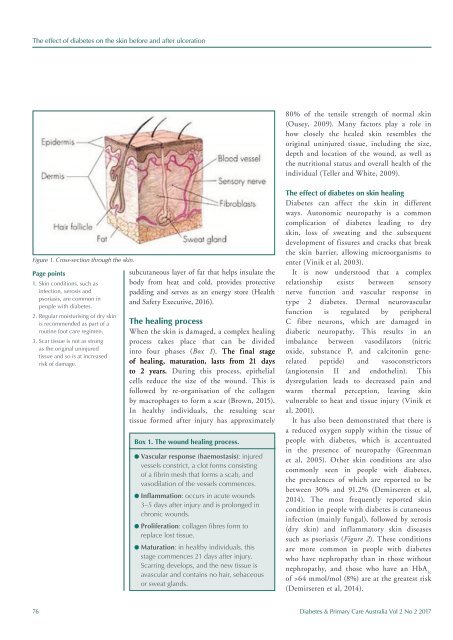DPCA2-2_issue_v3
Create successful ePaper yourself
Turn your PDF publications into a flip-book with our unique Google optimized e-Paper software.
The effect of diabetes on the skin before and after ulceration<br />
80% of the tensile strength of normal skin<br />
(Ousey, 2009). Many factors play a role in<br />
how closely the healed skin resembles the<br />
original uninjured t<strong>issue</strong>, including the size,<br />
depth and location of the wound, as well as<br />
the nutritional status and overall health of the<br />
individual (Teller and White, 2009).<br />
Figure 1. Cross-section through the skin.<br />
Page points<br />
1. Skin conditions, such as<br />
infection, xerosis and<br />
psoriasis, are common in<br />
people with diabetes.<br />
2. Regular moisturising of dry skin<br />
is recommended as part of a<br />
routine foot care regimen.<br />
3. Scar t<strong>issue</strong> is not as strong<br />
as the original uninjured<br />
t<strong>issue</strong> and so is at increased<br />
risk of damage.<br />
subcutaneous layer of fat that helps insulate the<br />
body from heat and cold, provides protective<br />
padding and serves as an energy store (Health<br />
and Safety Executive, 2016).<br />
The healing process<br />
When the skin is damaged, a complex healing<br />
process takes place that can be divided<br />
into four phases (Box 1). The final stage<br />
of healing, maturation, lasts from 21 days<br />
to 2 years. During this process, epithelial<br />
cells reduce the size of the wound. This is<br />
followed by re-organisation of the collagen<br />
by macrophages to form a scar (Brown, 2015).<br />
In healthy individuals, the resulting scar<br />
t<strong>issue</strong> formed after injury has approximately<br />
Box 1. The wound healing process.<br />
l Vascular response (haemostasis): injured<br />
vessels constrict, a clot forms consisting<br />
of a fibrin mesh that forms a scab, and<br />
vasodilation of the vessels commences.<br />
l Inflammation: occurs in acute wounds<br />
3–5 days after injury and is prolonged in<br />
chronic wounds.<br />
l Proliferation: collagen fibres form to<br />
replace lost t<strong>issue</strong>.<br />
l Maturation: in healthy individuals, this<br />
stage commences 21 days after injury.<br />
Scarring develops, and the new t<strong>issue</strong> is<br />
avascular and contains no hair, sebaceous<br />
or sweat glands.<br />
The effect of diabetes on skin healing<br />
Diabetes can affect the skin in different<br />
ways. Autonomic neuropathy is a common<br />
complication of diabetes leading to dry<br />
skin, loss of sweating and the subsequent<br />
development of fissures and cracks that break<br />
the skin barrier, allowing microorganisms to<br />
enter (Vinik et al, 2003).<br />
It is now understood that a complex<br />
relationship exists between sensory<br />
nerve function and vascular response in<br />
type 2 diabetes. Dermal neurovascular<br />
function is regulated by peripheral<br />
C fibre neurons, which are damaged in<br />
diabetic neuropathy. This results in an<br />
imbalance between vasodilators (nitric<br />
oxide, substance P, and calcitonin generelated<br />
peptide) and vasoconstrictors<br />
(angiotensin II and endothelin). This<br />
dysregulation leads to decreased pain and<br />
warm thermal perception, leaving skin<br />
vulnerable to heat and t<strong>issue</strong> injury (Vinik et<br />
al, 2001).<br />
It has also been demonstrated that there is<br />
a reduced oxygen supply within the t<strong>issue</strong> of<br />
people with diabetes, which is accentuated<br />
in the presence of neuropathy (Greenman<br />
et al, 2005). Other skin conditions are also<br />
commonly seen in people with diabetes,<br />
the prevalences of which are reported to be<br />
between 30% and 91.2% (Demirseren et al,<br />
2014). The most frequently reported skin<br />
condition in people with diabetes is cutaneous<br />
infection (mainly fungal), followed by xerosis<br />
(dry skin) and inflammatory skin diseases<br />
such as psoriasis (Figure 2). These conditions<br />
are more common in people with diabetes<br />
who have nephropathy than in those without<br />
nephropathy, and those who have an HbA 1c<br />
of >64 mmol/mol (8%) are at the greatest risk<br />
(Demirseren et al, 2014).<br />
76 Diabetes & Primary Care Australia Vol 2 No 2 2017
















